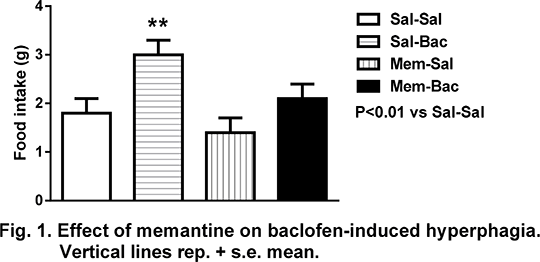Title: Effects of memantine on baclofen-induced hyperphagia in rats It has been previously demonstrated that the GABAB receptor agonist baclofen (bac) and agonists at the glutamate (glu) NMDA receptor increase food intake in rats by a central mechanism of action (see Ebenezer, 1990; Patel et al., 2010, Stanley et al, 2011). As part of a programme to investigate possible interactions of bac with central neurotransmitter / neuromodulator systems on ingestive behaviour, the present study was undertaken to examine the effects of the glu NMDA receptor antagonist memantine (mem) on bac-induced hyperphagia. Non-deprived male Wistar rats (n = 7; body weight – 375 – 455 g) were injected i.p. with either saline (sal) followed 15 min later by sal, sal followed by bac ( 2 mg kg-1), mem (2 mg kg-1) followed by sal, or mem (2 mg kg-1) followed by bac (2 mg kg-1). Immediately after the 2nd injection the rats were placed singly in separate experimental cages with free access to food and water. Cumulative food intake was measured as described previously (Ebenezer, 1990). A repeated measures design was used with each rat receiving all treatments. The data was analysed by ANOVA and post-hoc Student-Newman-Keuls test. The results for cumulative food intake at 60 min are shown in Fig. 1. Bac significantly increased food intake (P<0.01). Mem (2 mg kg-1) had no significant effect on food intake compared with control data. This is in contrast to higher doses of mem (e.g. 4 mg kg-1) which reduce food intake at 60 min (unpublished results). The hyperphagic effect of bac was attenuated by pre-treatment with mem, but this was not significant. Moreover, ANOVA revealed that there was no significant interaction between treatments (F(1,6) = 1.392, ns), which indicate that bac and glu probably act on different neural pathways to mediate their effects on feeding. However, further work is warranted to verify these findings. 
Ebenezer, I.S. (1990) NeuroReport, 1,73 – 76. Patel, S.M. et al. (2010) Eur. J. Pharmacol. 635, 129 – 134. Stanley, B.G et al. (2011) Physiol. Behav. 104, 40 – 46. Supported by the European Union InterReg TransChannel Neuroscience Network.
|


